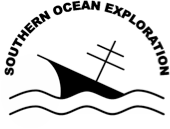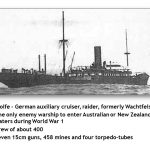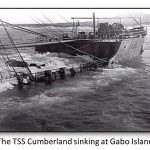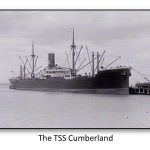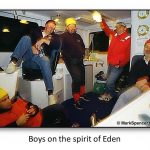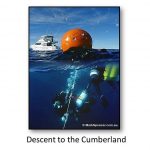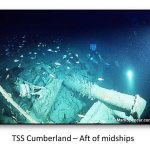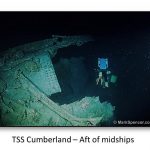TSS Cumberland
The Ship
History
The TSS Cumberland was a 474ft, 8993 gross tons, steel hulled steamship. Built in 1915, in Glasgow Scotland by Hamilton & Company and registered in London with the Official No: 139102. She was a four mast steamer, powered by four steam turbines. Designed in the latest merchant ship design, the Cumberland had a cruiser (naval type) stern and the most modern of appliances designed for the handling of both refrigerated and ordinary cargo. She had a sheltered deck, a bridge deck, deck house aft and a promenade deck.
On 6th July 1917, as apart of her voyage to the United Kingdom, she was just a couple of mile off Gabo Island and with no idea that she was steaming straight into a mine field that had been laid on the Australian eastern seaboard. The Cumberland was to become the first wartime casualty in home waters.
In 1938 an unsuccessful attempt to locate the wreck, for the purpose of salvaging the cargo was made by the salvage ship Viking Queen. It was not until 1952 that salvage crews finally recovered the bulk of her cargo, estimated at the time to be worth £300,000. A British crew, from the Foremost 17, using a diving bell (designed and built in Castlemaine, Victoria) fitted with a telephone and mechanical grab, and with the help of of legendary Melbourne Hard Hat diver John ‘Johnno’ Johnson, the bulk of the cargo of copper and lead ingots was recovered. They then went on to recover the last of the Niagra’s gold in New Zealand. The Australia Government not wanting to alarm the general public, claimed the sinking was the work of saboteurs working on the docks in Townsville. The news of the sinking of the Cumberland had far reaching repercussions internationally.
Ships Construction
A Steel twin screw steam ship, 9471 tons. Built Scotland, 1915; reg. London. 474 x 60 x 36.6 ft.
The Owners
Federal Steam Navigation Company Ltd. (who also owned the Cambridge, which was sunk by a mine in 1940 in Bass Strait)

The Final Voyage
The Cumberland was sunk on 6th July 1917, on a voyage to the UK, when in a convoy travelling south around Gabo Island she struck a mine laid by the notorious German raider Wolf. As one of the very first ships sunk in Australian waters by enemy action, the Cumberland become the subject of much discussion and controversy, with the Australian Government blaming the sinking on saboteurs working on the docks of Australia’s northern states.
The Cumberland was run aground on Gabo Island in order to hopefully undertake repairs and save the ship and the cargo. After extensive salvage and repair work, the tugs Champion and James Paterson took the Cumberland in tow, stern first, and headed for Sydney. On 11 August, when five mile south-east of Green Cape a strong north-easterly allowed water to enter the salvage patch, and finally she buried her bows, reared her stern 50 feet into the air then plunged into 51 fathoms of water.
Owned by the Federal Steam Navigation Company, she was lost under the command of Captain McGibbon, when she struck one of the 14 mines laid off Gabo Island in June 1917 by the German raider Wolf. The Cumberland was run aground on Gabo Island in order to hopefully undertake repairs and save the ship and the cargo.
After extensive salvage and repair work, the tugs Champion and James Paterson took the Cumberland in tow, stern first, and headed for Sydney. On 11 August, when five mile south-east of Green Cape a strong north-easterly allowed water to enter the salvage patch, and finally she buried her bows, reared her stern 50 feet into the air then plunged into 51 fathoms of water.
The Crew & Passengers
Captain McGibbon
Historical Photos
Project objective
After 18 months of research and investigation we were starting to close the gap a little on the whereabouts of the Cumberland . Then our search took us to ………NSW where we were put in contact with the Team Leaders of the Sydney Project (A NSW based dive crew that were searching for the HMAS Sydney and other wreck sites off the coast of NSW. The Cumberland had been on their list of must do’s. However, there had been various attempts over several years to locate the Cumberland without success. By welcoming us (and our recently gained information) to join Cumberland team, their enthusiasm had been rekindled and it was decided to mount a combined concerted effort to find the site.
On Saturday October 25th, Mark & Greg meet with Dave Appleby in Eden. Armed with information provided by CSIRO on some possible sites they had come across during Fish studies undertaken by them, we prepared for the 2 hour boat ride.
The 36m fishing vessel (Delcara) charted by the Sydney Project proved to be an excellent working platform for the task of searching all the possible sites. More often than not these things require a lot of luck and that’s exactly what we had, when in the first 10 minutes of searching the flat sandy bottom we had a 14m spike on the sounder! After another one and a half hours of sounding around, checking and rechecking all of our co-ordinates to ensure we didn’t leave the site until we had gathered all the information possible.
We didn’t know for sure that the site we have located was the Cumberland and we won’t know for sure until we do the 94m dive to positively ID the wreck.
Photos
Description of Wreck
Site Plan
News
Acknowledgements
References
With Thanks
Historical Photos
This is the ship that the British Navy gave to Australia after the sinking
of the original TSS Cumberland.
(Thanks to Peter Davidson (Queenscliff) Maritime Historian for his contribution).
Project Photos
Further Information Required
Any information on the Cumberland, ships general arrangement drawings, any information on the crew and officers.
